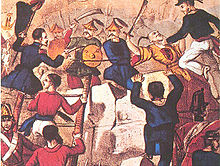Our website is made possible by displaying online advertisements to our visitors.
Please consider supporting us by disabling your ad blocker.
Opium Wars
| Opium Wars | |||||||||
|---|---|---|---|---|---|---|---|---|---|
 Combat at Guangzhou (Canton) during the Second Opium War | |||||||||
| |||||||||
| Belligerents | |||||||||
|
| Qing Dynasty | ||||||||
| Commanders and leaders | |||||||||
|
|
Daoguang Emperor Xianfeng Emperor Lin Zexu Sengge Rinchen | ||||||||
| Strength | |||||||||
|
~40,000 troops, American: 287 troops, 3 warships | ~110,000 troops | ||||||||
| Casualties and losses | |||||||||
| over 2,800 killed or wounded | 47,790 killed or wounded | ||||||||
The Opium Wars were two wars between China and two Western countries during the Qing dynasty. The first was between the United Kingdom and China and lasted from 1839 to 1842. The second was from 1856 to 1860 and involved France as well.[1]
The British, or rather the East India Company, brought opium to China. It brought it from the Bengal region of India to pay for Chinese goods such as porcelain.
Opium is a natural substance in the seeds of the opium poppy and is extracted from the poppy seeds. It was usually smoked for its narcotic effect but can be converted into opiates. By 1787, the company was sending 4,000 boxes, each with 77 kg of opium, per year. Trade grew even more in the 19th century.
The wars were also about other many things: opening China to European and American trade and colonizations. The Chinese defeats weakened the Qing dynasty.
- ↑ Hanes, William Travis; Frank Sanello (2002). Opium Wars: The addiction of one Empire and the corruption of another. p. 3.
Previous Page Next Page


